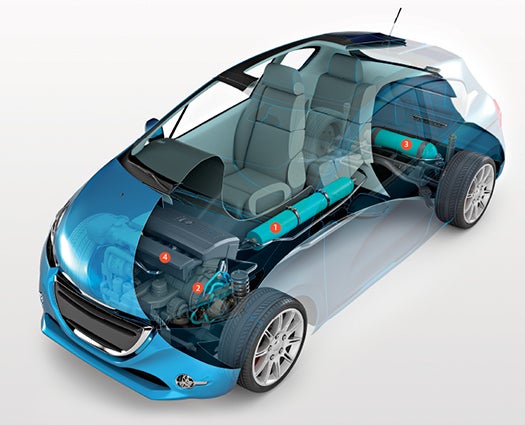The Car That Runs On Air
Bringing new meaning to running on fumes

For more than a century, air cars have remained a quixotic quest of engineers—an idealistic exercise with little long-term likelihood of entering mass production. As fuels go, air has obvious upsides: It’s ubiquitous, clean, and, best of all, free. But air requires energy to store energy because it must be compressed, limiting the utility of an all-air car. Two engineers from French automaker PSA Peugeot Citroën thought they could overcome that problem by pairing two tried-and-true technologies: a gasoline engine and hydraulics. To test the concept, they formed the Hybrid Air Program in 2010 and connected the engine of a subcompact car to a commercial airplane’s hydraulic system. “We were trying to push the project against a lot of people who didn’t trust the fact that we would succeed,” says engineer Karim Mokaddem.
The Hybrid Air powertrain, which Mokaddem designed with Andrés Yarce, uses a hydraulic pump and a piston to compress the nitrogen gas in a tank called the high-pressure accumulator. Hitting the accelerator releases the pressurized gas, which then moves hydraulic fluid through the same pump in reverse. The pump acts as a motor to power the wheels and the hydraulic fluid ends up in a second tank.
During normal driving, the system will switch between gas and air power, says Yarce. Much like with hybrid-electric vehicles, the gasoline engine provides a boost up steep hills and on the highway, and it repressurizes the nitrogen tank if the regenerative-braking system hasn’t done so. Yarce and Mokaddem predict that, for urban driving less than 43 miles per hour, between 60 and 80 percent of drive time will be under air power alone. Compared with gasoline-electrics, the Hybrid Air powertrain is lighter and cheaper, and there are no bulky batteries that wear out or intrude on passenger and trunk space. “The system is designed to live for the life of the vehicle,” says Yarce. “The only possible [maintenance] will be an air recharge.”
Yarce and Mokaddem’s prototype was so successful that PSA Peugeot Citroën has decided to manufacture production vehicles. The Hybrid Air powertrain will appear in all Citroën and Peugeot subcompacts as an option in Europe and possibly other international markets in 2016. The company hasn’t yet released a price, but it says that its air cars will cost around the same amount as other gasoline hybrids.

The Air Car
The Hybrid Air Car uses compressed nitrogen, which is held in a tank called the high-pressure accumulator.
A hydraulic pump and piston compress nitrogen in the accumulator. When the nitrogen is released (by pressing the accelerator), the pump runs in reverse. Acting now as a motor, it harnesses the energy of the moving hydraulic fluid to send power to the wheels.
After the hydraulic fluid passes through the motor, it flows to the low-pressure accumulator, where it is stored for later use.
A gasoline engine supplements the air power when accelerating or going up hills. This could be an 82-hp 1.2 L I3 for subcompacts and a 110-hp 1.6 L I4 for compacts.
This article originally appeared in the March 2014 issue of Popular Science.